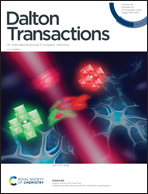Spectroluminescence measurements of the stability constants of CanUO2(CO3)3(4−2n)− complexes in NaClO4 medium and the investigation of interaction effects†
Abstract
The stability constants of ternary calcium uranyl tricarbonate complexes, CaUO2(CO3)32− and Ca2UO2(CO3)3(aq), were determined in NaClO4 medium at various ionic strengths using time-resolved laser-induced luminescence spectroscopy (TRLS) – also known as time-resolved laser-induced fluorescence spectroscopy (TRLFS). As in a previous study, the potential precipitation of schoepite (UO3·2H2O) and calcite (CaCO3) was avoided via titration of the triscarbonatouranyl complex with Ca2+ at varying pH values. The Ringböm coefficients relative to UO2(CO3)34− were individually evaluated under test sample conditions. Steadily enhanced luminescence intensity and increased decay-times were representative of complexation processes. The stoichiometry of calcium was quantified by slope analysis, and its measured intensity was corrected by using the corresponding Ringböm coefficient. The conditional formation constants, i.e. log10 Kn.1.3, were then assessed after rounding off the slope values to their nearest integers. Cumulative formation constants at infinite dilution log10 β°n.1.3, and specific ion interaction parameters ε were determined based on the experimental origin and slope values, respectively, over the range of 0.1–2.46 mol kgw−1 NaClO4 using the specific ion interaction theory (SIT) approach. The cumulative stability constants are log10 β°(CaUO2(CO3)32−) = 27.26 ± 0.04 and log10 β°(Ca2UO2(CO3)3(aq)) = 30.53 ± 0.06. The specific ion interaction coefficients are estimated to be ε(CaUO2(CO3)32−,Na+) = (0.02 ± 0.04) kgw mol−1 and ε(Ca2UO2(CO3)3(aq),NaClO4) = (0.18 ± 0.07) kgw mol−1. These latter values are different from the ones that were previously obtained in NaCl, and underlying causes are discussed from different aspects. This work provides valuable information to address the interaction effects between Ca–UO2–CO3 species and 1 : 1 type electrolytes. It is suggested that the affinity of the cation in a background electrolyte with CanUO2(CO3)3(4−2n)− (n = {1;2}) has to be taken into consideration at high ionic strengths, especially for globally non-charged species.



 Please wait while we load your content...
Please wait while we load your content...